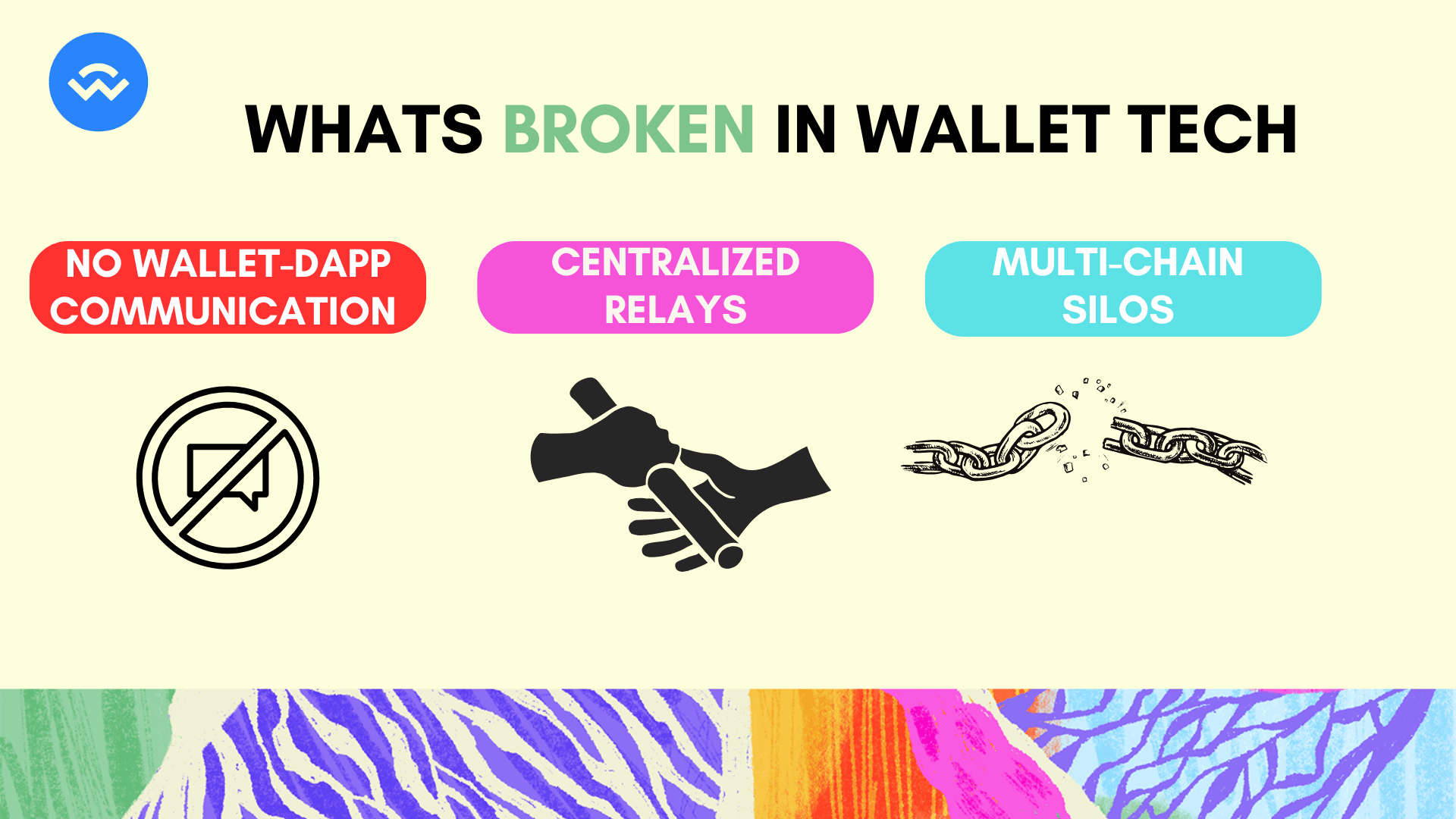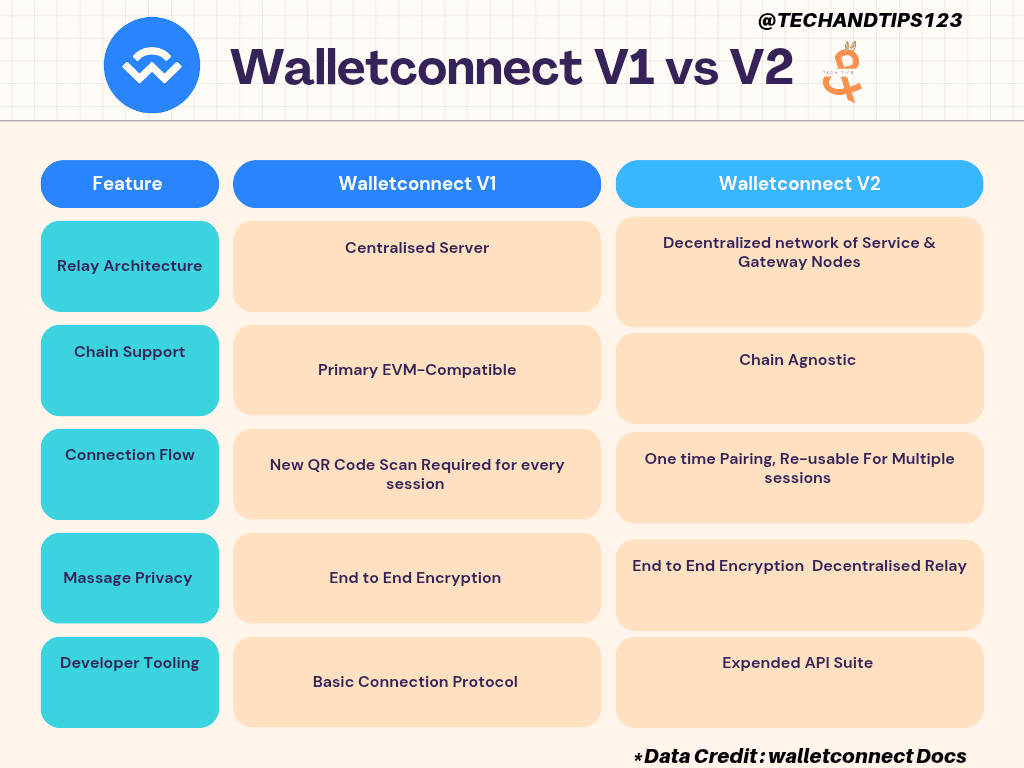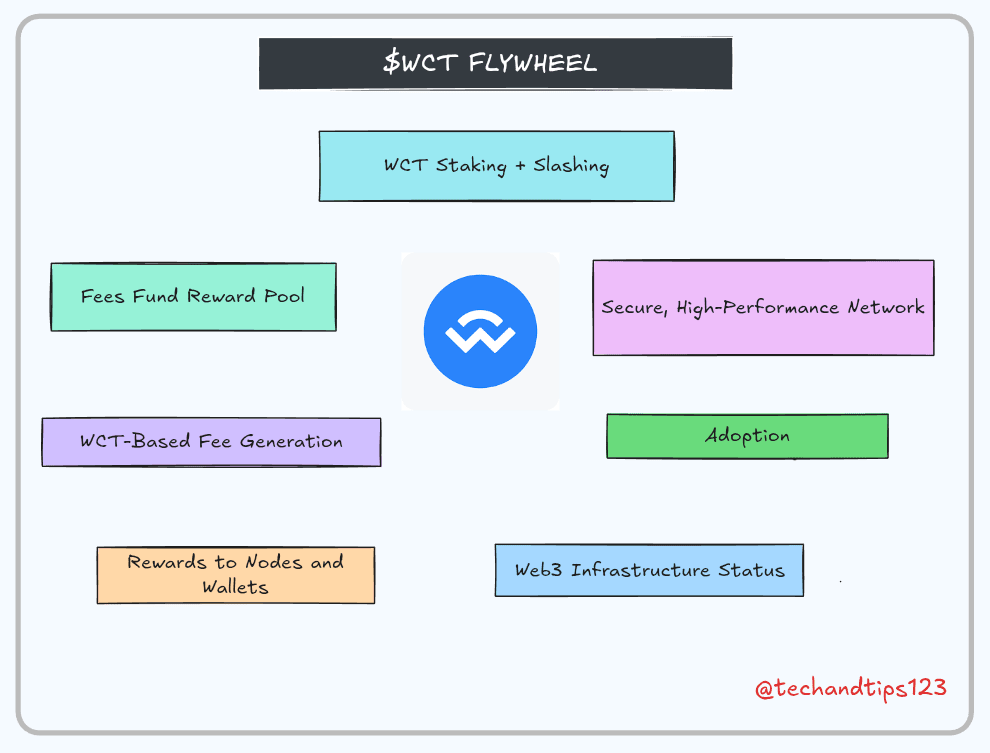
Web3 Always been Surrounded by Complex problems. Using a decentralized application was a fragmented and insecure experience, which was one of key barriers for mainstream users. The landscape was flooded by insecure practices, a developer nightmare of integrating countless wallets, and the "wallet wars" a race condition where browser extensions conflicted, creating a frustrating user experience.
WalletConnect founded in 2018 as the foundational communication protocol tried to solve this chaos. As an open-source project, its mission was to create a simple, secure bridge between any dApp and any wallet. It's main Focus was establishing an encrypted connection via a QR code, it solved the critical problem of interoperability and became the industry standard. By early 2025, it had facilitated over 275 million connections for 45 million unique users across 60,000+ dApps and 600+ wallets.
Today, WalletConnect is evolving into the WalletConnect Network, a decentralized, chain-agnostic messaging layer for web3. This transition is powered by its native token, WCT, which creates an economic model to align incentives among node operators, wallets, and dApps, guiding the network toward a permissionless, community-owned future. As web3 nears broader adoption, such decentralized and resilient infrastructure is no longer a luxury but a necessity.
▨ The Problem: What’s Broken?
Before WalletConnect, the web3 user experience was broken at the connection level, creating barriers to adoption, slowing development, and introducing risks.

🔹 The Wallet-dApp Communication Chasm : There was no standard, secure way for desktop dApps to communicate with mobile wallets, leading to a fragmented user experience. Users resorted to insecure workarounds like importing seed phrases into browser extensions, exposing their keys. Developers faced the inefficient task of building bespoke integrations for every wallet, stifling innovation.
🔹 The window.ethereum Wallet War : A flawed standard emerged where browser wallets competed to inject their provider into the single window.ethereum object. This created a "last one to load wins" race condition, resulting in unpredictable connection behavior and user frustration as the wrong wallet would often connect. It was a protocol-level flaw that created an unfair competitive landscape.
🔹The Risk of Centralized Relays: WalletConnect's v1 protocol relied on a centralized relay server. While messages were encrypted, the infrastructure was a single point of failure, vulnerable to outages, censorship, and attacks—contrary to web3 principles. The ecosystem traded long-term resilience for immediate usability.
🔹The Friction of a Multi-Chain World : The rise of multiple blockchains outpaced the capabilities of early tools. WalletConnect v1 was not designed for a multi-chain solution, assuming a single active chain per session. This forced users into a clunky process of manually switching networks within their wallet to interact with different dApps, creating friction and complicating development.
WalletConnect has consistently identified and solved the ecosystem's most pressing problems. V1 solved the initial communication gap. Its success highlighted the risk of a centralized relay, prompting the decentralized WalletConnect Network. Likewise, as its ease of use fueled wallet proliferation, it worsened the window.ethereum conflict, leading the project to champion the EIP-6963 standard. This iterative cycle of problem-solving is the hallmark of a resilient infrastructure project.
▨ What WalletConnect Is Doing Differently
To solve these issues, WalletConnect v2.0 and the decentralized WalletConnect Network represent an architectural leap forward, creating a resilient communication layer for web3.
The core of this evolution is a truly chain-agnostic design. Unlike the EVM-centric v1, v2.0 is a universal messaging standard supporting any blockchain, including non-EVM ecosystems like Solana, Cosmos, and Bitcoin. This is enabled by Chain Agnostic Improvement Proposals (CAIPs), which provide a standardized way to reference different chains and accounts, simplifying multi-chain communication.
A major UX improvement is the separation of Pairing from Session. In v1, users had to scan a QR code for every connection. Now, a Pairing is a one-time event establishing a secure channel between a wallet and a dApp. This cached pairing can be reused to propose new Sessions with a single click, reducing friction. Sessions are also more robust, with a default seven-day expiry to prevent indefinite, risky connections.

Walletconnect V1 vs V2
The most profound change is the move to a decentralized message relaying network. This censorship-resistant and private network consists of Service Nodes (forming a distributed storage layer) and Gateway Nodes (acting as entry points for routing). The entire network is end-to-end encrypted, acting as a "dumb pipe" with no visibility into message content, preserving user privacy.
This transition is being executed in phases to ensure stability. The network launched in a permissioned state with trusted professional node operators (including partners like Consensys, Kiln, and Ledger) to guarantee reliability. The ultimate goal, guided by the WCT token and governance, is a fully permissionless model where anyone who stakes WCT can operate a node, creating truly decentralized infrastructure. This pragmatic, phased approach de-risks the transition for critical infrastructure, using the WCT token's economic incentives to ensure high performance in a future trust-minimized environment.
▨ Key Components & Features
The WalletConnect Network is an expanding ecosystem of tools designed to create a comprehensive communication layer for web3, addressing key friction points for developers and users.

1️⃣ Chain-Agnostic Protocol : WalletConnect v2.0 is a universal communication standard, independent of any single blockchain. It bridges the entire web3 landscape, connecting dApps with wallets from diverse ecosystems like EVM chains, Solana, Cosmos, and Bitcoin, using standardized message formats (CAIPs) to unify a fragmented, multi-chain world.
2️⃣ Decentralized Relay Network : The network's backbone is a decentralized messaging layer of Service Nodes and Gateway Nodes, replacing the centralized v1 server. This censorship-resistant, private network uses end-to-end encryption, ensuring no intermediary can read user data. It is on a path to full permissionless operation secured by WCT staking.
3️⃣ Multi-Wallet Discovery (EIP-6963) : As a key champion of EIP-6963, WalletConnect helped solve the "wallet war" in browsers. This standard allows dApps to discover all installed wallet providers and present users with a clear choice, ending the chaotic race condition for the window.ethereum object. Its integration into Web3Modal shows a commitment to improving the entire ecosystem's UX.
4️⃣ Expanded API Suite : WalletConnect is evolving into a multi-product infrastructure provider with an expanded API suite. This includes the foundational Sign API (transaction signing), Notify API (push notifications), Chat API (wallet-to-wallet messaging), and Verify API (a security feature to combat phishing by authenticating dApp domains).
5️⃣ Smart Sessions & Link Mode : Next-gen features like Link Mode and Smart Sessions are in development. Link Mode enables instant, QR-code-free connections for mobile users. Smart Sessions aim to create persistent, intelligent connections for advanced, automated workflows like recurring payments and AI agent interactions, all while maintaining user consent.
▨ How WalletConnect Works
The WalletConnect v2.0 protocol provides a secure workflow for connecting wallets to dApps and signing transactions, prioritizing user control by ensuring private keys never leave the user's device.

🔺 Step 1: Initiation (The dApp Request) : A user clicks "Connect Wallet" in a dApp. The dApp's SDK generates a session proposal specifying required chains (e.g., Ethereum, Solana) and methods (e.g., eth_sendTransaction). It sends this to the WalletConnect Relay Network and displays the returned URI as a QR code.
🔺 Step 2: Pairing & Session Proposal (The Wallet's Response) : The user scans the QR code with their mobile wallet. The wallet decrypts the URI to establish a secure, end-to-end encrypted Pairing with the dApp via the Relay Network. This pairing is cached for future use, eliminating repeated scans. The wallet then displays the dApp's session proposal and requested permissions to the user.
🔺 Step 3: User Approval & Session Establishment : The user reviews the request in their wallet and, if they trust the dApp, taps "Approve." This sends a signed approval back through the Relay Network, establishing the Session. The dApp updates to show the connected address, and the user can manage the connection from their wallet. The session can persist for up to seven days.
🔺 Step 4: Transaction Signing : When the user initiates an action like a token swap, the dApp constructs the transaction and sends it as a JSON-RPC request to the wallet via the active session. The wallet receives the request and presents a clear, human-readable summary of the transaction details to the user for review.
🔺 Step 5: Final Confirmation & Broadcast : The user confirms the transaction in their wallet, typically with a biometric scan or PIN. The wallet then signs the transaction locally with the private key, which is never exposed. The signed transaction is broadcast to the blockchain, and the transaction hash is sent back to the dApp as confirmation.
▨ Value Accrual & Growth Model
The WalletConnect Network is designed as a self-sustaining ecosystem where value accrual is driven by a virtuous cycle of utility, incentives, and decentralization.
✅ Solving Core Connectivity for a Multi-Chain World : The network's primary demand comes from its role as essential web3 plumbing. It solves a two-sided market problem by providing a neutral, chain-agnostic standard that connects dApps with the widest range of wallets, and vice versa. Its value grows as it integrates more ecosystems and champions standards like EIP-6963.
✅ A Multi-Sided Incentive Model : The network's growth is fueled by rewarding key participants with WCT. Node Operators are rewarded for providing reliable, low-latency relaying and storage. Wallets can earn WCT by staking and meeting performance benchmarks, with additional incentives for those in the "WalletConnect Certified" program. Key SDKs receive an initial WCT allocation to encourage participation.
✅ The Fee-and-Reward Loop : The network will eventually capture value through a fee mechanism. DApps and SDKs will pay small fees in WCT for messaging services, which will be channeled into a reward pool for node operators and participating wallets. This creates a direct feedback loop: more activity generates more fees, funding larger rewards, which incentivizes better service and strengthens the network.
✅ Permissionless and Decentralized Architecture : The network is built for horizontal scalability. Its decentralized design allows new nodes to be added seamlessly to handle increasing load. The ultimate scalability lever is the transition to a fully permissionless model, allowing network capacity to grow organically with community participation, unconstrained by a single entity.
✅ Better UX Drives Adoption, Which Funds Better UX : The growth model is a self-reinforcing loop. A superior UX attracts more developers and users, increasing network value and forming the basis for future fees. These economic resources are then used to reward participants and fund further UX improvements (like the Notify API or Smart Sessions), which in turn attracts the next wave of users, restarting the cycle at a larger scale.
▨ Token Utility & Flywheel ($WCT )
The WalletConnect Token (WCT) is the economic and governance instrument of the WalletConnect Network, designed to coordinate participants and secure the infrastructure. It is a standard ERC-20 token, initially launched on Optimism and since expanded to other chains like Ethereum and Solana, with a fixed total supply of 1 billion.

❍ Token Use Cases
Payments (Fees): In the future, pending a governance vote, WCT will be used by dApps and SDKs to pay for network messaging services. This fee mechanism is designed to be the core economic engine funding the network's operations and rewards.
Rewards: WCT is the primary incentive for network participation. A significant portion of the supply is allocated to a rewards pool distributed to node operators for performance and high-quality wallets for facilitating connections and providing excellent UX.
Staking: Staking WCT is the core security mechanism. Node operators and wallets must stake WCT to participate and earn rewards, providing an economic bond ("skin-in-the-game"). The stake amount and lock-up duration influence reward share and governance power, and are subject to slashing for malicious behavior or poor performance.
Governance: WCT holders govern the WalletConnect Network, proposing and voting on critical decisions like enabling fees, protocol upgrades, and ecosystem grants. This model progressively transfers control to the community, ensuring the network remains a neutral piece of public infrastructure.
❍ The Flywheel
The WalletConnect economic flywheel is a self-reinforcing system that converts network utility into sustainable value.

$WCT Flywheel
The cycle begins with adoption, as developers and users flock to the network for its simple, secure, and chain-agnostic connectivity. This establishes WalletConnect as an indispensable web3 infrastructure. This utility enables value capture through future WCT-denominated fees paid by dApps and SDKs for messaging services, creating a direct demand driver for the token that scales with network activity.
The captured value is then reinjected to incentivize quality and security. Fees fund a reward pool distributed to node operators and high-quality wallets. To earn these rewards, participants must stake WCT, which reduces the token's liquid supply and enforces good behavior through the threat of slashing for poor performance. This high-performance, secure network drives further adoption, completing the loop. Governance acts as the steering system, allowing WCT holders to fine-tune the economic engine to ensure WalletConnect evolves into a permanent, community-owned pillar of the decentralized web.



